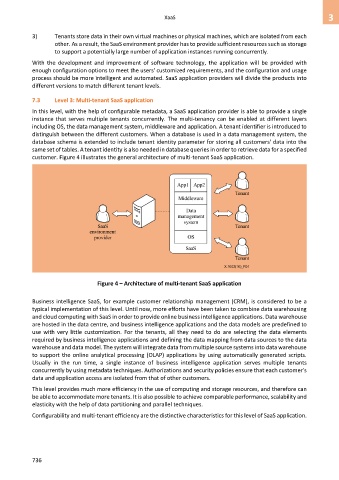Page 744 - Cloud computing: From paradigm to operation
P. 744
XaaS 3
3) Tenants store data in their own virtual machines or physical machines, which are isolated from each
other. As a result, the SaaS environment provider has to provide sufficient resources such as storage
to support a potentially large number of application instances running concurrently.
With the development and improvement of software technology, the application will be provided with
enough configuration options to meet the users' customized requirements, and the configuration and usage
process should be more intelligent and automated. SaaS application providers will divide the products into
different versions to match different tenant levels.
7.3 Level 3: Multi-tenant SaaS application
In this level, with the help of configurable metadata, a SaaS application provider is able to provide a single
instance that serves multiple tenants concurrently. The multi-tenancy can be enabled at different layers
including OS, the data management system, middleware and application. A tenant identifier is introduced to
distinguish between the different customers. When a database is used in a data management system, the
database schema is extended to include tenant identity parameter for storing all customers' data into the
same set of tables. A tenant identity is also needed in database queries in order to retrieve data for a specified
customer. Figure 4 illustrates the general architecture of multi-tenant SaaS application.
Figure 4 – Architecture of multi-tenant SaaS application
Business intelligence SaaS, for example customer relationship management (CRM), is considered to be a
typical implementation of this level. Until now, more efforts have been taken to combine data warehousing
and cloud computing with SaaS in order to provide online business intelligence applications. Data warehouse
are hosted in the data centre, and business intelligence applications and the data models are predefined to
use with very little customization. For the tenants, all they need to do are selecting the data elements
required by business intelligence applications and defining the data mapping from data sources to the data
warehouse and data model. The system will integrate data from multiple source systems into data warehouse
to support the online analytical processing (OLAP) applications by using automatically generated scripts.
Usually in the run time, a single instance of business intelligence application serves multiple tenants
concurrently by using metadata techniques. Authorizations and security policies ensure that each customer's
data and application access are isolated from that of other customers.
This level provides much more efficiency in the use of computing and storage resources, and therefore can
be able to accommodate more tenants. It is also possible to achieve comparable performance, scalability and
elasticity with the help of data partitioning and parallel techniques.
Configurability and multi-tenant efficiency are the distinctive characteristics for this level of SaaS application.
736

